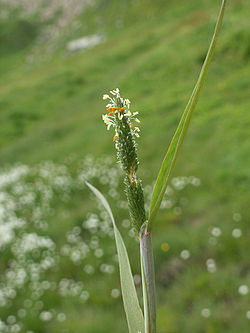| Alopecurus aequalis | |
|---|---|
 | |
| Scientific classification | |
| Kingdom: | Plantae |
| Clade: | Tracheophytes |
| Clade: | Angiosperms |
| Clade: | Monocots |
| Clade: | Commelinids |
| Order: | Poales |
| Family: | Poaceae |
| Subfamily: | Pooideae |
| Genus: | Alopecurus |
| Species: | A. aequalis |
| Binomial name | |
| Alopecurus aequalis | |
| Synonyms | |
| |
Alopecurus aequalis is a common species of grass known as shortawn foxtail or orange foxtail. [3] It is native to much of the temperate Northern Hemisphere from Eurasia to North America. It is most commonly found in areas near fresh water, such as the margins of ponds and ditches. [4]

